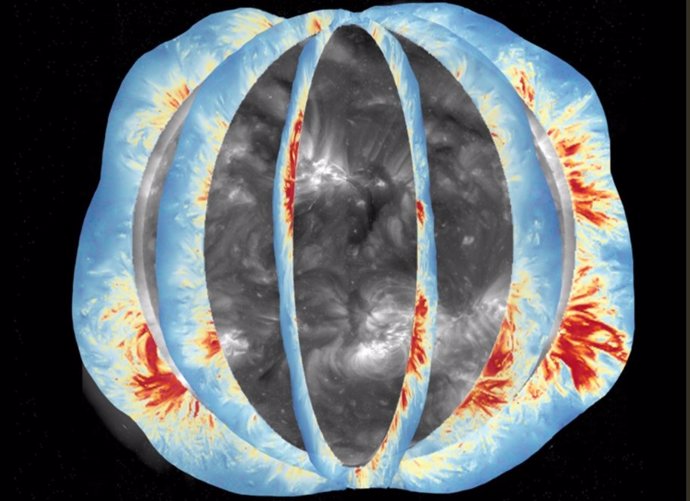Illustration of the global coronal magnetic field as the Sun rotates. The background shows the solar corona observed in the extreme ultraviolet waveband, with maps of the global coronal magnetic field measured at different times superimposed – NCAR
Oct. 4 () –
For the first time, scientists have taken almost daily measurements of the global magnetic field of the solar corona, a region of the sun that it has only been observed irregularly in the past.
The resulting observations are providing valuable insights into the processes driving intense solar storms that impact critical technologies, and therefore lives and livelihoods, here on Earth, according to the authors.
An analysis of the data, collected over eight months by an instrument called the Enhanced Multichannel Coronal Polarimeter (UCoMP), has been published in Science.
The solar magnetic field is the main driver of solar storms, which can pose threats to power grids, communication systems and space technologies such as GPS. However, our ability to understand how the magnetic field builds up energy and bursts out has been limited by the challenge of observing it in the solar corona, the sun’s upper atmosphere.
Measuring the magnetism of the region through standard polarimetric methods typically requires large and expensive equipment. which to date has only been able to study small segments of the crown.
However, the combined use of coronal seismology and UCoMP observations allows researchers to produce consistent and complete views of the global coronal magnetic field, the view of the entire Sun seen during a solar eclipse.
“Global mapping of the coronal magnetic field has been an important missing part of the study of the Sun,” he said. in a statement Zihao Yang, lead author who conducted this research as a PhD graduate at Peking University, China, and is now a postdoctoral fellow at the US National Science Foundation’s National Center for Atmospheric Research (NSF/NCAR).
“This research is helping us fill a crucial gap in our understanding of coronal magnetic fields, which are the source of energy for storms that can impact Earth,” he said.
The international team is made up of researchers from Northumbria University, United Kingdom; NSF NCAR; Peking University, China; and the University of Michigan. The UCoMP instrument is operated by NSF NCAR at the Mauna Loa Solar Observatory.
The UCoMP is primarily a coronagraph, an instrument that uses a disk to block sunlight, similar to an eclipse, making it easier to observe the corona. It also combines a Stokes polarimeter, which captures other spectral information such as coronal line intensity and Doppler velocity.
The researchers applied a method called coronal seismology to trace magnetohydrodynamic (MHD) shear waves in the UCoMP data. The MHD waves provided them with information that allowed them to create a two-dimensional map of the strength and direction of the coronal magnetic field.
During the UCoMP study, the research team produced 114 magnetic field maps between February and October 2022, or one almost every two days.
“We are entering a new era of solar physics research in which we can routinely measure the coronal magnetic field,” Yang said.
The observations also produced the first measurements of the coronal magnetic field in the polar regions. The Sun’s poles have never been directly observed because the Sun’s curve near the poles keeps it just out of our view from Earth.
Although the researchers did not directly see the poles, for the first time they were able to take measurements of the magnetism they emit. This was partly due to the improved quality of the data provided by UCoMP as the Sun was close to solar maximum. The typically weak emissions from the polar region have been much stronger, making it easier to obtain results from the coronal magnetic field in the polar regions.










![[Img #74692]](https://thelatestnews.world/wp-content/uploads/2024/12/What-do-11-and-12-year-old-boys-and-girls-300x200.jpg)

Add Comment